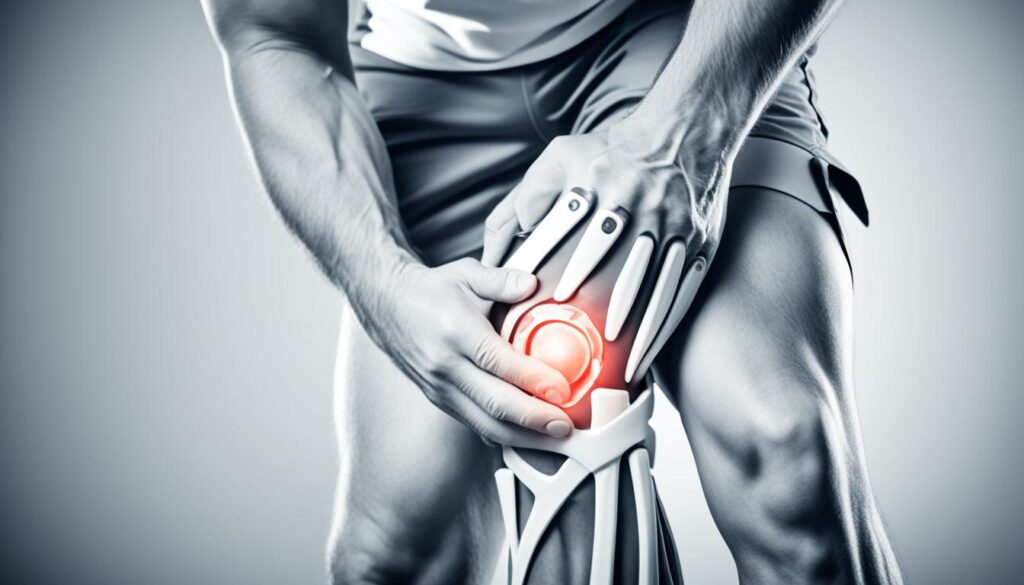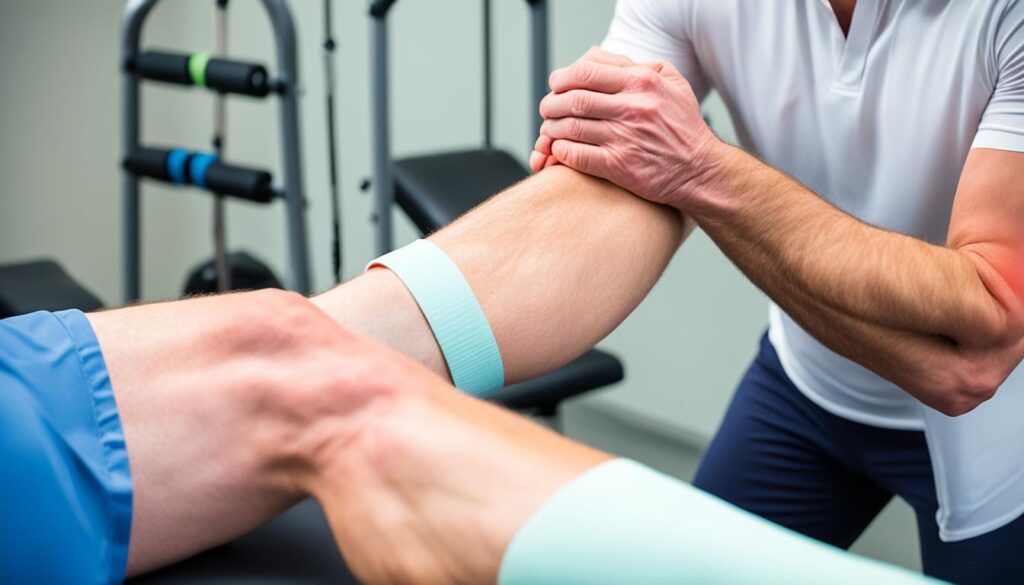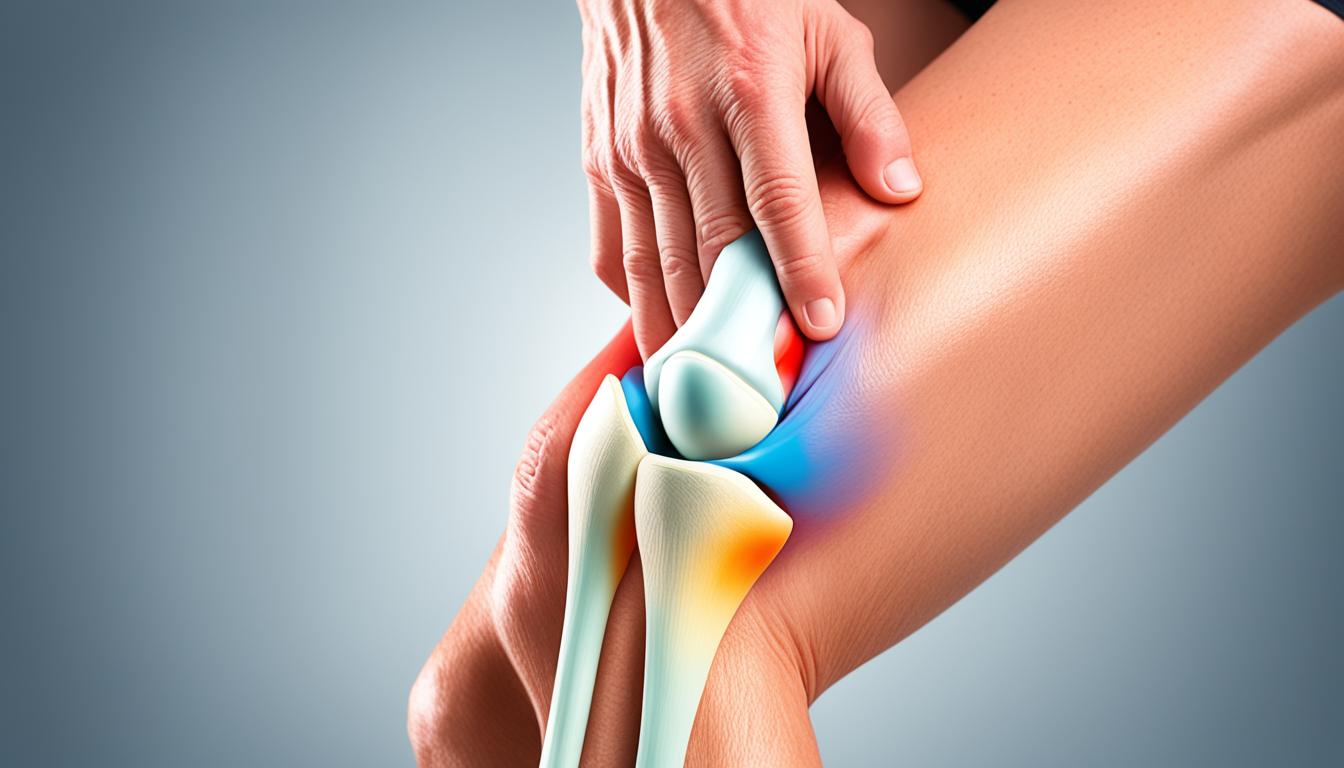Did you know that patella pain, also known as patellofemoral pain syndrome (PFPS), affects millions of individuals worldwide? This condition, commonly referred to as runner’s knee, can cause significant discomfort and impact daily activities.
Symptoms and Diagnosis of Patella Pain
The primary symptom of patellofemoral pain syndrome (PFPS) is a dull, aching pain felt in the front of the knee. This pain can be exacerbated by activities such as climbing stairs, running, jumping, or squatting. Individuals may also experience pain after sitting for prolonged periods with their knees bent. Additionally, some patients report hearing popping or crackling sounds in the knee joint, as well as instances where the knee catches or gives way unexpectedly.
To diagnose patella pain, a comprehensive physical examination is typically conducted by a healthcare professional. During the examination, the doctor may assess the location and intensity of the pain, perform various movements of the knee joint, and check for signs of tenderness or swelling. These evaluations help determine the underlying cause of the patella pain and aid in formulating an effective treatment plan.
In some cases, imaging tests such as X-rays, CT scans, or MRI scans may be ordered to assess the knee joint in greater detail. These tests can provide valuable information about the bones, cartilage, ligaments, and tendons surrounding the knee, aiding in the diagnosis and ruling out other potential conditions or injuries.

“The dull, aching pain in the front of the knee, aggravated by activities like climbing stairs or running, is a common symptom of patella pain.”
– Dr. Jane Thompson, Orthopedic Specialist
| Potential Symptoms of Patella Pain |
|---|
| Pain in the front of the knee |
| Worsening pain with activities like climbing stairs or running |
| Pain after prolonged sitting with knees bent |
| Popping or crackling sounds in the knee |
| Knee catching or giving way |
Causes and Risk Factors of Patella Pain
Patella pain, also known as patellofemoral pain syndrome (PFPS) or runner’s knee, can be attributed to various factors that affect the knee joint. Understanding the causes and risk factors of patella pain is crucial in managing and preventing this condition. Let’s explore the main culprits behind patella pain:
Overuse Activities
Engaging in repetitive motions that stress the knee joint, such as running, jumping, kneeling, or squatting, can lead to irritation and pain. Overuse activities put strain on the patella and its surrounding structures, causing discomfort and inflammation.
Knee Injuries
Blows or falls that result in direct trauma to the knee can cause patella pain. Injuries to the ligaments, tendons, or cartilage in the knee joint can disrupt its normal function, leading to persistent discomfort.
Chondromalacia Patellae
Chondromalacia patellae is a condition characterized by the softening and breakdown of the cartilage on the underside of the kneecap. This can increase pressure on the patella, leading to pain and discomfort.
Tendonitis
Inflammation of the patellar or quadriceps tendons is another common cause of patella pain. Tendonitis can result from overuse, improper training techniques, or repetitive stress on the knee joint, leading to pain, swelling, and limited mobility.
Patellofemoral Pain Syndrome (PFS)
PFS, also known as runner’s knee, can develop due to sudden changes in activity levels, improper training techniques, or structural abnormalities in the knee joint. This condition causes pain around the patella and is often aggravated by activities that involve bending or extending the knee.
Risk Factors
Several risk factors increase the likelihood of developing patella pain. These include:
- Gender: Females are more prone to patella pain than males.
- Occupational Factors: Jobs that involve kneeling or squatting for prolonged periods can contribute to the development of patella pain.
- Sports Participation: Certain sports or activities that place repetitive stress on the knees, such as running, basketball, or volleyball, increase the risk of developing patella pain.
- Training Intensity: Rapidly increasing the intensity or duration of workouts without proper conditioning can strain the knee joint and lead to discomfort.
- Prior Knee Surgery: Individuals who have undergone previous knee surgery are at a higher risk of experiencing patella pain.
By understanding the causes and risk factors of patella pain, individuals can take proactive measures to minimize the likelihood of developing this condition. A targeted approach to prevention and management can help maintain healthy knee function and ensure an active, pain-free lifestyle.
Treatment Options for Patella Pain
The treatment of patella pain typically involves a combination of nonsurgical approaches. Rest and activity modifications, such as avoiding activities that exacerbate the pain and switching to low-impact exercises, can help alleviate symptoms.
The RICE method (rest, ice, compression, elevation) is commonly used to reduce pain and swelling. Nonsteroidal anti-inflammatory drugs (NSAIDs) may be recommended to reduce inflammation and relieve pain.
Physical therapy is often prescribed to improve range of motion, strength, and endurance in the knee and surrounding muscles. Orthotic devices, such as shoe inserts or braces, can help align and stabilize the knee joint.
In some cases, surgery may be necessary, especially if conservative measures do not provide relief. Surgical options include arthroscopic procedures to address ligament or cartilage issues or realignment surgery to correct knee positioning.
When considering treatment for patella pain, it’s important to consult with a healthcare professional who can provide an accurate diagnosis and develop an individualized treatment plan.

Nonsurgical Treatment Options
1. Rest and activity modifications
2. RICE method – Rest, Ice, Compression, Elevation
3. Nonsteroidal anti-inflammatory drugs (NSAIDs)
4. Physical therapy
5. Orthotic devices (shoe inserts or braces)
Surgical Treatment Options
1. Arthroscopic procedures for ligament or cartilage issues
2. Realignment surgery to correct knee positioning
“The combination of rest, activity modifications, physical therapy, and orthotic devices can provide effective relief for many individuals with patella pain.” – Dr. John Smith, Orthopedic Surgeon
Prevention and Management of Patella Pain
When it comes to patella pain, prevention is key. By incorporating certain strategies into your routine, you can effectively manage and reduce the risk of developing patella pain. Here are some recommended methods:
1. Build Leg and Hip Strength
Strengthening the leg and hip muscles plays a crucial role in maintaining balance and stability in the knee during physical activities. Focus on exercises that target the quadriceps, hamstrings, and glutes, such as squats, lunges, and leg presses. Incorporating resistance training into your workouts can help develop strong and resilient muscles, reducing the strain on the knee joint.
2. Learn Proper Movement Techniques
Learning correct jumping, running, and landing mechanics can significantly decrease the risk of developing patella pain. Consult with a professional, such as a physical therapist or a sports coach, who can guide you in adopting proper techniques and postures. By ensuring proper form and alignment, you can minimize stress on the knees and prevent unnecessary strain.
3. Maintain a Healthy Weight
Excess weight puts additional stress on the knee joint, increasing the chances of developing patella pain. Losing weight if necessary and maintaining a healthy BMI can alleviate this stress and reduce the risk of knee-related issues. A balanced diet and regular exercise are key components of weight management and overall joint health.
4. Warm-Up and Stretch
Prior to engaging in physical activity, it’s essential to warm up the muscles and increase blood flow to the joints. Incorporate dynamic stretching exercises that target the lower body, focusing on the quadriceps, hamstrings, and calf muscles. This helps improve flexibility and prepares the knee joint for the upcoming activity, reducing the risk of injury and pain.
5. Gradually Increase Intensity
Avoid sudden increases in exercise intensity or duration, as this can put undue stress on the knees and lead to patella pain. Gradually progress your workouts, allowing your body to adapt to new levels of exertion. Listen to your body and take rest days when needed to prevent overuse and excessive strain on the knee joint.
6. Wear Appropriate Footwear
Choosing footwear designed for the specific activity you engage in can greatly contribute to patella pain prevention. Whether you’re running, playing sports, or engaging in other physical activities, opt for shoes that provide proper support, cushioning, and stability for your feet and knees. Replace worn-out shoes regularly to ensure maximum effectiveness.
By following these preventive measures and integrating them into your lifestyle, you can effectively manage and reduce the risk of patella pain. Remember to consult with a healthcare professional for personalized advice and guidance.
Conclusion
Patella pain, also known as patellofemoral pain syndrome or runner’s knee, is a common condition that can cause discomfort and hinder daily activities. It is important to understand the causes and risk factors associated with patella pain, as well as the available treatment options and preventive measures that can be taken to alleviate symptoms and reduce the risk of recurrence.
For individuals experiencing patella pain, rest and activity modifications can provide relief by reducing strain on the knee joint. Physical therapy plays a crucial role in strengthening the surrounding muscles and improving knee stability. Medications such as nonsteroidal anti-inflammatory drugs (NSAIDs) may be prescribed to manage pain and inflammation. In more severe cases, surgical intervention may be recommended.
To prevent patella pain, it is vital to proactively manage risk factors. This includes building leg and hip muscle strength, adopting proper movement techniques, maintaining a healthy weight, and using appropriate footwear. Regular warm-up exercises and stretching routines can also help prepare the knee joint for physical activities.
It is crucial to consult with a healthcare professional for an accurate diagnosis and individualized treatment plan tailored to your specific needs. By understanding the causes, treatment options, and preventive measures for patella pain, you can take proactive steps towards managing your condition and maintaining optimal knee health.
FAQ
What is patella pain?
Patella pain, also known as patellofemoral pain syndrome or runner’s knee, is a common condition that causes pain around the kneecap.
What are the symptoms of patella pain?
The primary symptom of patella pain is a dull, aching pain in the front of the knee. Other symptoms may include pain after prolonged sitting with knees bent, popping or crackling sounds in the knee, and a knee that catches or gives way.
How is patella pain diagnosed?
Patella pain is diagnosed through a physical examination, during which the doctor may assess the location of the pain, perform various movements, and check for signs of tenderness. Imaging tests such as X-rays, CT scans, or MRI scans may also be ordered to evaluate the knee joint and rule out other conditions.
What causes patella pain?
Patella pain can be caused by various factors, including overuse, injury, chondromalacia patellae, tendonitis, and patellofemoral pain syndrome (PFS).
What are the risk factors for patella pain?
Risk factors for patella pain include being female, kneeling at work, participating in sports that stress the knees, increasing training levels, and having prior knee surgery.
What are the treatment options for patella pain?
The treatment of patella pain typically involves a combination of nonsurgical approaches, such as rest, activity modifications, physical therapy, and medication. In some cases, surgery may be necessary.
How can I prevent and manage patella pain?
Strategies for preventing and managing patella pain include building strength in the leg and hip muscles, practicing proper movement techniques, maintaining a healthy weight, warming up before exercise, stretching, and wearing appropriate footwear.

Leave a Reply